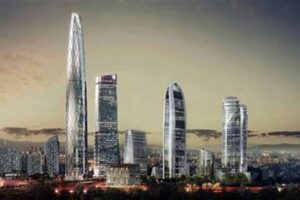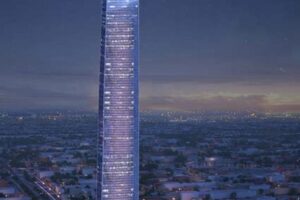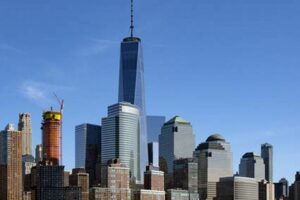Located in the heart of Moscow, the Moscow International Business Center, also known as Moscow City, is a modern architectural marvel composed of skyscrapers that dominate the city skyline.
The Moscow City skyscrapers stand as symbols of Russia’s economic and technological prowess. The complex houses various businesses, financial institutions, and luxury apartments, making it a hub for commerce and high living. It is also a popular tourist destination, offering breathtaking views of the city from its observation decks.
The construction of Moscow City began in the late 1990s and continues to this day, with new skyscrapers constantly being added to the complex. Some of the most iconic buildings in Moscow City include the Federation Tower, the tallest building in Europe, and the Mercury City Tower, known for its distinctive shape. The complex also features a number of other notable structures, such as the Imperia Tower, the City of Capitals, and the Evolution Tower.
1. Height
The soaring heights of Moscow City skyscrapers are a defining characteristic of this architectural complex. Several buildings within the complex rank among the tallest in Europe, contributing to Moscow’s reputation as a city with an impressive skyline. This vertical growth symbolizes the city’s economic and technological advancements, as well as its architectural ambitions.
- Landmark Status: The Federation Tower, the tallest building in Europe, and the Mercury City Tower, known for its distinctive shape, have become iconic landmarks of Moscow. Their towering presence adds to the city’s global recognition and architectural prestige.
- Engineering Marvels: Constructing skyscrapers of such heights requires exceptional engineering expertise. The Moscow City skyscrapers showcase innovative structural designs and advanced construction techniques, pushing the boundaries of architectural engineering.
- Panoramic Views: The observation decks located in some of the skyscrapers offer breathtaking panoramic views of Moscow and its surroundings. Visitors can enjoy unparalleled vistas of the city from these elevated vantage points.
- Vertical Communities: The skyscrapers house a diverse mix of businesses, luxury apartments, and amenities, creating vertical communities within the complex. This fosters a vibrant and self-contained urban environment.
The impressive heights of Moscow City skyscrapers not only contribute to the city’s skyline but also reflect its economic growth, architectural ingenuity, and the creation of unique urban spaces.
2. Architecture
The architectural diversity of Moscow City skyscrapers is a key element that contributes to their significance and visual appeal. The complex features a harmonious blend of architectural styles, ranging from modern and contemporary to neoclassical and art deco. This eclectic mix creates a visually stunning cityscape that reflects Moscow’s rich architectural heritage while embracing modern design sensibilities.
The juxtaposition of different architectural styles in Moscow City skyscrapers showcases the evolution of architectural trends and the influence of various design movements. The sleek, glass-clad facades of modern skyscrapers stand alongside the ornate, stone-clad facades of neoclassical buildings, creating a dynamic and visually engaging urban environment. This architectural diversity also reflects the varied purposes of the skyscrapers, from commercial offices and luxury apartments to cultural venues and entertainment centers.
The practical significance of understanding the connection between architecture and Moscow City skyscrapers lies in appreciating the complex’s unique identity and urban planning. The diverse architectural styles contribute to the overall aesthetic appeal of Moscow City, making it a visually striking and memorable part of the Moscow skyline. Furthermore, the integration of different architectural elements allows for a variety of building functions and caters to the diverse needs of businesses and residents within the complex.
3. Business
The connection between business and Moscow City skyscrapers is integral to the complex’s significance and role in the city’s economy. Moscow City has become a major hub for commerce and investment due to its concentration of businesses and financial institutions within its skyscrapers.
- Corporate Headquarters: Many large Russian and international corporations have established their headquarters in Moscow City skyscrapers. This includes companies from various industries, such as energy, finance, and technology. The presence of these corporate headquarters brings together key decision-makers and industry leaders, fostering business growth and collaboration.
- Financial Hub: Moscow City is home to numerous banks, investment firms, and other financial institutions. The complex provides a centralized location for financial activities, facilitating investment, capital raising, and financial transactions. The proximity of these institutions creates a dynamic and competitive financial ecosystem.
- International Business Center: Moscow City has positioned itself as a major international business center. Its skyscrapers accommodate businesses from around the world, providing a platform for global trade and partnerships. This international presence enhances Moscow’s economic competitiveness and strengthens its position in the global business landscape.
- Economic Growth: The concentration of businesses and financial institutions in Moscow City contributes to the city’s economic growth. The skyscrapers act as catalysts for job creation, tax revenue generation, and increased investment in the surrounding areas. The economic benefits extend beyond Moscow City, positively impacting the city’s overall prosperity.
In conclusion, the connection between business and Moscow City skyscrapers is multifaceted, contributing to the complex’s role as a major hub for commerce and investment. The presence of corporate headquarters, financial institutions, and international businesses creates a vibrant and dynamic business environment, fostering economic growth and strengthening Moscow’s position in the global business arena.
4. Luxury
The connection between luxury and Moscow City skyscrapers is deeply intertwined, contributing to the complex’s distinct charact
er and appeal. The skyscrapers offer an array of luxurious apartments and amenities, catering to a discerning clientele seeking an elevated lifestyle in the heart of Moscow.
The presence of luxury apartments and amenities within Moscow City skyscrapers reflects the growing demand for high-end residential spaces in the city. These apartments are designed to provide the ultimate in comfort, convenience, and exclusivity. They feature spacious layouts, high-quality finishes, and state-of-the-art appliances. Additionally, residents have access to a range of exclusive amenities, such as private gyms, swimming pools, and concierge services.
The practical significance of understanding the connection between luxury and Moscow City skyscrapers lies in its impact on the real estate market and the city’s overall economic development. The presence of luxury apartments and amenities attracts wealthy individuals and investors to Moscow City, contributing to the growth of the luxury real estate sector. Furthermore, the demand for luxury living spaces stimulates investment in the development and maintenance of high-end residential properties, creating job opportunities and boosting the local economy.
In conclusion, the connection between luxury and Moscow City skyscrapers is multifaceted, contributing to the complex’s appeal to a discerning clientele and its impact on the city’s real estate market and economic growth. The presence of luxurious apartments and amenities elevates the lifestyle of residents and enhances the overall prestige of Moscow City as a desirable destination for both living and investment.
5. Tourism
The connection between tourism and Moscow City skyscrapers is significant, as these architectural marvels have become popular tourist destinations in their own right. Observation decks located within the skyscrapers offer breathtaking panoramic views of Moscow, enhancing the city’s appeal to both domestic and international visitors.
- Landmark Attractions: Moscow City skyscrapers have become iconic landmarks, attracting tourists from around the world. The Federation Tower, Mercury City Tower, and other notable buildings are must-see destinations for visitors seeking to experience Moscow’s architectural grandeur.
- Panoramic Views: The observation decks located in the skyscrapers provide unparalleled panoramic views of Moscow. Visitors can enjoy breathtaking vistas of the city’s historic landmarks, sprawling urban landscape, and the meandering Moskva River.
- Tourist Amenities: Many of the skyscrapers offer additional amenities to enhance the tourist experience. Guided tours, interactive exhibits, and souvenir shops provide visitors with a deeper understanding of the architecture, history, and significance of Moscow City.
- Economic Impact: The tourism industry plays a vital role in Moscow’s economy. The popularity of Moscow City skyscrapers as tourist destinations generates revenue for businesses, creates employment opportunities, and contributes to the overall economic growth of the city.
In conclusion, the connection between tourism and Moscow City skyscrapers is multifaceted and mutually beneficial. The skyscrapers have become iconic landmarks that attract tourists, while the observation decks offer breathtaking views and contribute to Moscow’s overall appeal as a tourist destination. The tourism industry, in turn, supports the economic growth of the city and enhances its global recognition.
6. Sustainability
Moscow City skyscrapers are not only architectural marvels but also showcases of sustainable design and environmental consciousness. Several buildings within the complex incorporate innovative features that minimize their environmental impact and promote energy efficiency.
One notable example is the Mercury City Tower, which boasts a glass facade designed to reduce heat gain and energy consumption. The tower also features a rainwater harvesting system that collects and reuses rainwater for irrigation and other non-potable purposes. Additionally, the building’s lighting system is optimized to reduce energy usage without compromising illumination levels.
Another example is the Federation Tower, which utilizes a double-skin facade that provides thermal insulation and natural ventilation, reducing the need for mechanical heating and cooling systems. The tower also incorporates energy-efficient lighting and motion sensors to further minimize energy consumption.
The integration of sustainable design features in Moscow City skyscrapers is not only environmentally responsible but also economically beneficial. Energy-efficient systems reduce operating costs for building owners and tenants, while green roofs provide insulation, reducing heating and cooling demands. Moreover, sustainable buildings attract environmentally conscious tenants and investors, enhancing the overall value and appeal of the complex.
In conclusion, the connection between sustainability and Moscow City skyscrapers highlights the growing importance of environmentally conscious design in modern architecture. By incorporating sustainable features, the skyscrapers not only reduce their environmental footprint but also contribute to a more sustainable and livable urban environment.
7. Future Development
The ongoing development of Moscow City is a testament to its dynamic nature and its role as a constantly evolving hub. The plans for additional skyscrapers and infrastructure projects underscore the complex’s commitment to innovation, growth, and enhancing the urban landscape of Moscow.
The future development of Moscow City is driven by several factors. Firstly, the growing demand for office and commercial space in Moscow necessitates the construction of new skyscrapers to meet the needs of businesses and investors. Secondly, the complex’s success in attracting both domestic and international tenants has encouraged developers to expand its capacity and offerings.
The practical significance of understanding the connection between future development and Moscow City skyscrapers lies in its implications for urban planning and economic growth. The addition of new skyscrapers and infrastructure will create employment opportunities, boost the real estate market, and contribute to the overall economic development of Moscow.
In conclusion, the future development of Moscow City is an integral part of its ongoing evolution as a major business and cultural center. The planned skyscrapers and infrastructure projects will not only expand the complex’s capacity and offerings but also contribute to the economic growth and urban transformation of Moscow.
Frequently Asked Questions about Moscow City Skyscrapers
This section addresses common questions and misconceptions surrounding Moscow City skyscrapers, providing concise and informative answers to enhance your understanding of these architectural marvels.
Question 1: What is the tallest skyscraper in Moscow City?
The tallest skyscraper in Moscow City is the Federation Tower, standing at an impressive height of 373.7 meters.
Question
2: How many skyscrapers are there in Moscow City?
As of 2023, there are 23 completed skyscrapers in Moscow City, with several more under construction or in the planning stages.
Question 3: What is the architectural style of Moscow City skyscrapers?
Moscow City skyscrapers showcase a diverse range of architectural styles, including modern, contemporary, neoclassical, and art deco, creating a visually stunning cityscape.
Question 4: Are Moscow City skyscrapers sustainable?
Yes, several Moscow City skyscrapers incorporate sustainable design features such as energy-efficient systems, rainwater harvesting, and green roofs, promoting environmental consciousness and reducing their ecological footprint.
Question 5: What is the significance of Moscow City skyscrapers?
Moscow City skyscrapers are symbols of Russia’s economic prowess and architectural achievements. They house businesses, financial institutions, luxury apartments, and various amenities, contributing to Moscow’s status as a global metropolis.
Question 6: What is the future of Moscow City?
Moscow City is undergoing continuous development, with plans for additional skyscrapers and infrastructure projects. This ongoing evolution reflects the complex’s commitment to growth, innovation, and enhancing Moscow’s urban landscape.
In conclusion, Moscow City skyscrapers are architectural marvels that represent Moscow’s economic, technological, and architectural prowess. Their diverse styles, sustainable features, and ongoing development contribute to the city’s global recognition and its status as a vibrant and dynamic metropolis.
This concludes our FAQ section. For further inquiries or detailed information, please consult official sources or seek professional advice.
Tips for Understanding Moscow City Skyscrapers
To delve deeper into the world of Moscow City skyscrapers and appreciate their significance, consider these insightful tips:
Tip 1: Explore Architectural DiversityMoscow City skyscrapers showcase a fascinating array of architectural styles. From the sleek modernity of the Federation Tower to the neoclassical grandeur of the Imperia Tower, each building contributes to the complex’s visual appeal. Understanding these diverse styles enhances your appreciation for the architectural heritage and contemporary design trends reflected in Moscow City’s skyline.Tip 2: Learn about Sustainable DesignSustainability is an integral aspect of Moscow City’s skyscrapers. Many buildings incorporate eco-friendly features such as energy-efficient systems and green roofs. Understanding these sustainable design practices highlights the complex’s commitment to environmental responsibility and its contribution to a greener urban environment.Tip 3: Discover Business and Economic SignificanceMoscow City skyscrapers are not only architectural wonders but also hubs of commerce and finance. Housing numerous businesses, financial institutions, and corporate headquarters, the complex plays a vital role in Moscow’s economy. Understanding this business significance provides insights into the city’s economic growth and its status as a global financial center.Tip 4: Experience Panoramic ViewsSeveral Moscow City skyscrapers offer observation decks with breathtaking panoramic views of the city. Taking advantage of these vantage points allows you to appreciate the scale and grandeur of Moscow’s urban landscape, including iconic landmarks and sprawling vistas.Tip 5: Appreciate Cultural ConnectionsMoscow City skyscrapers are not just structures; they are also cultural landmarks. Understanding their history, architectural influences, and role in shaping Moscow’s identity deepens your appreciation for the city’s cultural heritage and its ongoing evolution.Tip 6: Explore Future DevelopmentsMoscow City is continuously evolving, with plans for additional skyscrapers and infrastructure projects. Staying informed about these developments provides insights into the complex’s future growth and its impact on Moscow’s urban landscape.ConclusionBy following these tips, you can gain a multifaceted understanding of Moscow City skyscrapers, appreciating their architectural diversity, sustainable design, business significance, cultural connections, and future developments. This knowledge enriches your exploration of Moscow and enhances your appreciation for these architectural marvels that define the city’s skyline.
Conclusion
Moscow City skyscrapers stand as symbols of Russia’s economic prowess and architectural achievements. Their diverse styles, sustainable features, and ongoing development contribute to Moscow’s status as a global metropolis. Understanding these architectural marvels provides insights into Moscow’s history, culture, and its trajectory as a modern, forward-looking city.
As Moscow City continues to evolve, its skyscrapers will remain iconic landmarks, shaping the city’s skyline and serving as a testament to its ambition and innovation. The complex’s commitment to sustainability, business growth, and cultural expression ensures its enduring significance in the years to come.







